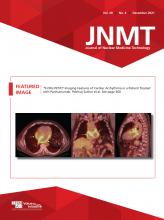Abstract
A patient wearing the mandatory face mask because of the ongoing coronavirus disease 2019 pandemic underwent postradioiodine therapy scintigraphy. The spot view of the neck showed an area of uptake that was later demonstrated to be caused by contamination of the mask. This finding has led to updating the scan procedure for posttherapy scintigraphy by replacing the patients’ masks before the scan acquisition.
Guidelines for radioiodine therapy (RAIT) of differentiated thyroid cancer recommend that whole-body scintigraphy be performed after every RAIT. The aim of post-RAIT scintigraphy is not only to characterize the extent of the thyroid remnant but also to detect unknown lesions. Areas of focal iodine uptake outside the physiologic ones are suggestive of metastatic disease, although radioactive contamination artifacts in 131I imaging after RAIT are a known issue (1).
CASE REPORT
A patient treated with 2,960 MBq of 131I to ablate a thyroid remnant was referred for posttherapy scintigraphy 5 d after RAIT administration. Because of the ongoing coronavirus disease 2019 pandemic, the patient was required to wear a face mask during his time in the hospital. The mask was kept on during the whole imaging acquisition procedure.
After the whole-body scan, an anterior spot view of the neck, including the laterocervical region and part of the chest, was acquired as required by the protocol in use. Iodine uptake was found in the residual thyroidal tissue in the neck, as well as in the mucosae of the nose and mouth. An area of intense iodine uptake below the right corner of the patient’s mouth was also present (Fig. 1). Given the unusual appearance of the iodine distribution pattern, the technologist suspected a possible artifact due to iodine contamination of the mask. Therefore, the patient was given a new mask to wear and the scan was repeated.
Post-RAIT spot view of neck shows hot spot below right corner of patient’s mouth.
The newly acquired spot view showed the disappearance of the high-activity area (Fig. 2). Lateral views also demonstrated a physiologic distribution of radioiodine.
Spot view of neck acquired while patient was wearing new mask. Hot spot has disappeared.
DISCUSSION
Contamination artifacts in 131I imaging are often due to body secretions, perspiration, or saliva (2,3). In particular, radioactive iodine can be detected in patients’ saliva up to 2 wk after RAIT (4).
In a recently reported artifact linked to a contaminated face mask, the abnormal iodine distribution was considered to be due to the presence of 131I in the exhaled air remaining in the mask (5). In our case, given the intense activity shown on the scintigraphy, our finding more likely refers to salivary imbibition after prolonged use of the same mask than to exhalation only.
If not recognized as an artifact, further characterization of the area of uptake would have been required. The differential diagnosis should have included increased uptake in the right sublingual or submandibular glands, a metastatic lymph node, or a bone metastasis of the mandible.
CONCLUSION
Unusual patterns of iodine distribution on post-RAIT scintigraphy must be evaluated accurately. Patients undergoing post-RAIT scintigraphy in our hospital are currently asked to wear a new mask just before the scan begins. Used masks are disposed of as radioactive waste.
DISCLOSURE
No potential conflict of interest relevant to this article was reported.
Footnotes
Published online July 30, 2021.
- Received for publication April 15, 2021.
- Revision received May 27, 2021.









